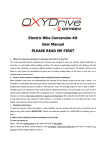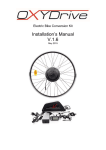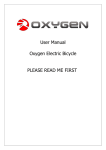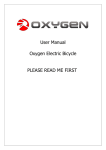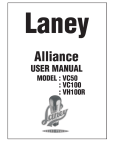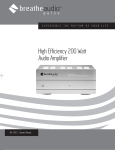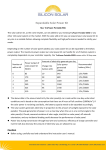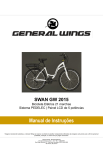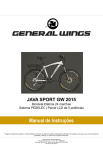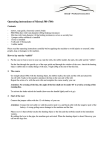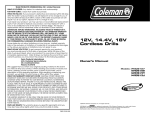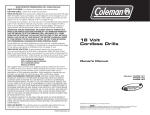Download User`s Manual V.1.1 PLEASE READ ME FIRST
Transcript
Electric Bike Conversion Kit User’s Manual V.1.1 January 2012 PLEASE READ ME FIRST Table of contents: 1. 2. 3. 4. 5. 6. Page Concept and description of electric assistance Recommendation for washing Control of electric assist Turning the power on Selecting the level of pedal assist Battery charge indicator Specific recommendations for use of electric assistance Common errors when using electric assist Purpose of power displayer Maximising the range and life time of the battery Battery, Charger and the charging process The battery charging The battery care and maintenance Charger and the labels contained on the charger Battery storage and customers duty of care 2 3 3 3 3 3 4 4 4 4 5 6 6 6 7 7 1. Concept and description of electric assistance Concept and purpose of electric assistance is to help cyclists to ride the bicycles with the power assist coming from the electric motor. This is particularly helpful during the hill climbing and the head winds. The electric motor can be fitted in variety of locations including the front and rear hub as well as the centrally placed crank drives. 2. Recommendation for washing All washing of electric motor, battery and the controller should be carried on with special attention and minimal use of water or any other liquids. During washing it’s best to use wet but almost dry sponge and cloth. IMPORTANT: Never use the pressurised KARTCHER’s for washing. 3. Control of electric assist Turning the power on In order to switch the power on two steps should be completed. Step 1. The power has to be turned on at the battery. At the right hand side of the battery there is a green button which should be in the ON position. Step 2. On the handlebar there are three control buttons. The button in the middle should be pressed for approx 2-3 seconds until display will show all the figures. Selecting the levels of pedal assist On the same group of handle bar switches there is an option of selecting the level of assistance in the pedelec mode. The levels of assist are from 1 to 5 with one being the slowest and least powerful and 5 being the fastest and giving maximum assist. It is entirely up to the user which level of pedal assist wants to ride on. NOTE: For achieving maximum range from a single battery charge it is recommended not to use the level 5 at all times. It is the most powerful level of pedal assist and as result the power consumption is at the highest level. 3 Battery charge level indicator The OXYDrive conversion kit is equipped with the battery indicators stating the level of battery charge and the remaining charge left in the battery. One indicator is located on the LCD display located n the top left corner. The less power is left in the battery the less fields on the indicator will be displayed. The second indictor located on the battery. In order to check the charge condition the button in the middle has to be pressed in. The indicator works in the exactly the same way as indicator on the LCD display. The full charge shows all lights on, then less power left in the battery the less lights will be showing on. 4. Specific recommendations for use of electric assistance Common errors when using electric assist It is important to understand what type of errors users make when using the electric assist. One of the major errors that users make when using the electric assist is misunderstanding the concept of the electric assist. It is important to understand that having electric assist fitted to the bike will turn our bike into a scooter or moped which can be used by ‘’twist and go’’. The user should bear in mind that the power of the motor fitted to the bike is only 250W on the average output. As a result it has enough power to give the assist while cycling uphill or against headwinds. It may however not be enough to climb average weight person up the hill by just twisting the throttle or pulling a trailer with a child at back. It is worth to remember that riding on the twist throttle only is perfectly fine as long as we ride it on the flat or downhill or against mild headwind. Riding with the throttle only mode up the hill may cause the motor, battery or controller to overheat or blown the fuse on the battery which will stop the entire system. Purpose of power displayer The main console is equipped with a power displayer showing a current power output on the motor. The figures are shown in WATTS. This function apart from being fantastic feature showing the user current power can also be used to determine how much strain we put on the system. Once you start using OXYDrive you will notice that the peak power can reach even 400 or 500 Watts. This is the maximum power that the motor can achieve in the peak and this normally occurs during the start or hill climbing. The power displayer shows the user how much strain is put on the entire system and if cycling with average power output close to 500Watts then we know we are using 100% power available. We can use it with no problems for a while however this level of power should not be used at all times or during a very long hill climbing. We recommend using the power with anything between the 100 to 250Watts of power output on the flat road and up to 350W during long hill climbing. This way you can maximise the efficiency and lifetime of the battery, motor and the entire system. Please read the next chapter explaining in detail how to maximise the range and lifetime of all components. 4 Maximising the range and the life time of the battery This chapter explains how to get most out of your battery and how to maximise lifetime of the entire system too. Probably most of the OXYDrive users have a driving licence or had already driven a car before. The example and the point we try to make in this manual is that riding an electric bike is not much different from driving the car and that the same rules apply for the bikes as well as for the cars. It’s all about the physics. These days driving a car fast becomes a privilege and the cost of raising fuel prices do not seem to see it ending. With the continuously rising fuel prices we try to get more mpg (less l/100km in the EU) when driving the car. In order to do this we try to keep the top recommended tyres pressure, carry with us least weight so do not keep the useless luggage in the car boot etc etc. We also tend to drive more carefully by not accelerating very quickly and always driving in the right gear so the engine RPM is just optimal for the speed we drive. The above example is just to illustrate what we can do to reduce the fuel consumption. Riding an electric bike is exactly the same and it very much depends on us how we can maximise the range and reduce the power consumption. Though we can even say that electric assist is even more sensitive then a car when it comes to power saving. Here is our ABC A. Always try to give your own pedal assistance. Then more your own effort you put into cycling the less power the motor will have to provide, the less strain will go on the motor, battery and the controller. It also gives you some exercise when you pedal assist your bike. B. When cycling uphill try to give your own assistance but also look at the power meter display. Try to avoid the levels of 400-500Watts of power output as much as you can as it drains the battery very quickly and put a lot of strain on the motor too. It’s like with driving a car, we normally drive a car within 2000 to 3000 RMP as it’s most efficient in this range and it’s the healthiest level for the engine too. Although most car engines are capable of achieving 5000-6000 RPM we don’t drive at those levels very often unless we overtake for few seconds. It consumes then a lot of fuel and it’s very unhealthy for the engine to drive for longer period of time. Same rule applies to the electric bike. If you ride it with the top power output it has a negative impact on the battery power consumption as well as it’s unhealthy for the motor and the controller system due to high current level. C. When climbing up very sharp hills we might actually find that our cursing speed has decreased to approx 6-7 mph (10-12km/h) regardless of whether we are in the pedal assist mode no 3 or 5. By bringing again our car example what happens here is the loss of efficiency. Each motor or car engine has its own optimal level of operations when it generates the highest efficiency. Giving an example if we drive the car at 20mph up the hill on the 5th gear with only 1100RPM it does not matter if we press the accelerator a lot or just a little bit. The car will usually drive with the same speed of 20mph and won’t accelerate because the engine is not working at it’s optimal level. By pressing the accelerator pedal 5 we can however notice that power consumption increases a lot but the speed does not really increase. Again the same rule applies with the bike hub motor. All hub motors have their own optimal operational level when the efficiency is at the peak. If the cursing speed drops down below certain level the motor then enters the level of inefficiency. What happens then is the high power consumption but low power output. Coming back to the beginning of the point C when we climb this sharp hill we should never use the level 5 of pedal assist if our cursing speed dropped below 10mph because the motor is then inefficient a with large amount of power going through the motor coils all electric power is simply turned into heat and not redirected onto the drive system. If the cursing speed drops below 10mph then please use the pedal assist level 3 at maximum. This will prevent the surplus of power turning into heat and the motor will use just enough power. 5. Battery & charger and the charging process Battery charging It is important to follow these few steps before the first charge. Firstly, the battery must be fully charged before the first use. In order to charge the battery, you will first need to plug power socket into the mains and the charger’s round plug into the battery’s socket. Once it’s done, you can plug the charger’s main plug to the electricity socket. It is important that it is done in this specific order as connecting the charger’s main plug first may cause a short circuit. The charging cycle is competed once the green light appears on the charger. The red light on means that the battery is still in the charging process and it should not be disconnected from the charger until the green light appears. Battery care and maintenance Once the battery has been fully discharged, it is always best to charge it on the same day, but not earlier than approx 10-20 minutes after your bike ride as the battery needs some time to cool of. If you are planning not to use your bike for a longer period of time, it is very important that you charge the battery before. Batteries stored for longer period of time should be charged for approx 1 hour every 2 months - neglecting this result in the battery loosing its voltage and gradual damage to the battery. 6 Labels contained on the charger Each battery has a appropriate label applied on the battery case. This label contains basic information about the battery care and safety instructions which strictly have to be followed. Failure to follow the battery guidelines may be dangerous and may invalidate the battery warranty. IMPORTANT: Never open the battery case - the battery case should only be open by an authorised service centre appointed by Oxygen Bicycles. Unlawful breach of this rule will automatically invalidate the battery warranty. Opening the battery case by unauthorised individuals may cause a serious injury or even death. Oxygen Bicycles is not responsible for any accidents and damages caused by unlawful battery maintenance 6. Battery storage and customers duty of care Storage recommendations This is an important part of this manual this is why it should be read with attention. All lithium batteries should be stored at the home temperatures (16-24C). It is important not to store the battery in wet, humid and cold conditions as this may affect the battery performance. Lithium batteries when stored for a longer period of time (anything from one week to few months) without using them should be charged at approx 50-70% charge state. IMPORTANT: Please do not store batteries 100% fully charged as well as completely flat with close to 0% charge state. DUTY OF CARE Each customer purchasing OXYDrive is obliged to read this manual and follow the duty of care recommendation guidelines. Each battery when stored for a longer period then one week should be recharged for approx 30min to one hour in order to make sure that the battery is at approx 50-70% charge level. Failure to follow these guidelines may cause the battery to loose its capacity and voltage what at the worst resort may cause a complete damage to the battery. WHY RECHARGE??? REASONING EXPLAINED IN DETAIL Recharging process is essential because each lithium polymer battery is built up with many smaller internal cells. All the cells being connected together create a cell groups which are maintained by one BMS (Battery management system) which is nothing else but a small tiny computer which continuously balances the cells and makes sure that the voltage is same on cell groups. By doing so it consumes very little amount of power which drain the battery. This is why it is essential to re-charge the battery every approx 2 months. Failing to do re-charge the battery may result in the battery cells to die. If the voltage on each individual cell drop below 2.8V and 28V on the entire pack then the cells are very likely to die leaving them with no option of recovery. All 7 batteries claimed under the warranty and found with a voltage lower then 28V are very likely to have a warranty void due to lack of care and negligence. As a user please take it seriously and make sure your battery is stored at approx 50-70% charge state. This applies mainly to the autumn and winter months when bikes are not very frequently used. Thanks for reading, still got some question please email us at [email protected] or call directly on +447738866502 or +442081443350 8








